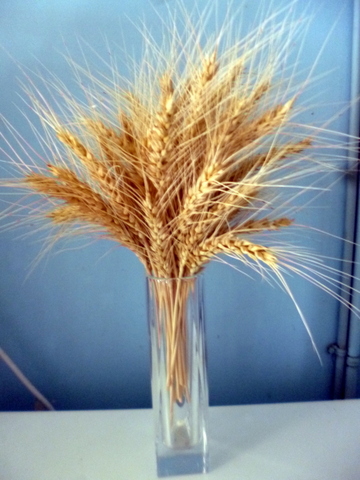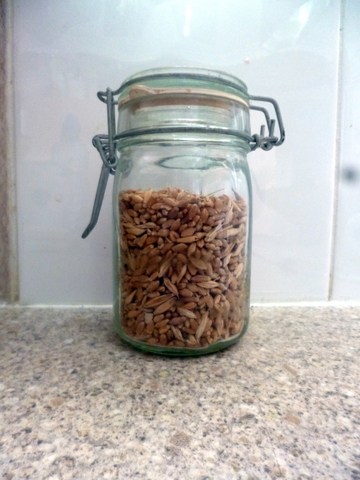For many years I have been interested in the processes involved with the food that we eat, and the staff of life is no exception. I wanted to grow the wheat, process it, grind it and then make bread out of it. I tried it quite a few years ago and this is how it all came out.
I picked a bit of veggie patch against the back fence that was about 5 metres long by about 2 metres wide, although I only planted a swath about 1 metre wide with wheat. To plant I chose the ages old method of broadcasting the seed, in the words of Big Arnie (Schwartzenegger) – “Bad idea”. Like a lot of seemingly simple things, to do it well actually requires a fair amount of skill, so the result was an uneven seed distribution. If I had a larger area to plant I would beg, borrow or steal a hand seed drill, for the small amounts I would scratch some rows into the soils and trickle the seed in by hand and then cover over with a hoe.
The wheat that I used was chook feed from a produce merchant and as such I assumed it to be a spring wheat. Wheat comes in two varieties – spring and winter, the winter wheat being planted in autumn and requiring a period of chilling to set seed, the spring wheat, surprisingly enough being planted in……… spring! According to the books, spring wheat is “soft” or low in gluten and good for cakes and pastry but not bread, whereas the winter wheat is “hard”, higher in gluten and suitable for bread. Just between you and me, I’ve used the soft wheat for bread and damned if I could tell the difference; I suspect that it is important to commercial bakers after the most return from their materials. Anyway…….
According to Jackie French you should sow the wheat about 4 cm deep in rows about 18 cm apart, and by and large I would not argue with her. I have found that when I use wheat straw as mulch the residual seed germinates and I get wheat plants all through the garden and most set seed if I let them. I suppose the thing is if you plant fertile wheat seed you will get some sort of crop and it is all about maximizing your return.
Once I had planted the wheat and watered it I found that I had instant popularity with my feathered friends and I think this is a major reason why my yield was so poor. These days I have found that dud CDs drilled and suspended on fishing line over the area to be protected works a treat, and keeps the little buggers off. If you are a practicing Luddite (including all you neo-Luddites) I remember my next door neighbour when I was a kid achieving the same results with shards of a mirror suspended in a similar manner.
The wheat plants that came up were not as numerous as I had hoped and it seems that the feathered plunderers had done their job well. To be fair those that did come up appeared to grow fairly well, and after some months produced fine green seed heads, which had slowly dried out by early summer. I have a small sickle which I have had for years just waiting around to fulfil its destiny and help me harvest this crop of wheat. OK, the sickle was a bit over the top for the amount of wheat I had to harvest and a pair of large scissors would have probably done a better job. The soil was reasonably soft and when the sickle hit the wheat stalks it tended to cause them to fold over and pull out of the ground, rather than cut through them.
Regardless of this fact I eventually had an armful of wheat stalks with attached heads and in best traditional I proceeded to wrap them up into a bundle (or “stook”) to dry. With the amount of wheat I had, it made one stook, but it’s the thought that counts (right?). I transferred my stook to the concrete floor of the garage and left it there under cover to dry for a couple of weeks.
With the wheat dry I needed to thresh it to remove the grain from the husk. I had read that one gentleman placed the wheat on a tarp then beat it with a small kids plastic baseball bat, but lacking that I used a stick for the same purpose. The idea is that you lay the stook down on a tarp then strike the heads of the wheat stalks to dislodge the grain. It worked reasonable well. But I suspect I didn’t get all of the grain that there was.
I then removed the stalks from the tarp and poured the resulting grain from the tarp into a bowl. To remove the wheat from the chaff (There is a great saying! I must remember to use that more often) the material is winnowed. This means dropping the wheat and chaff in a stream past a current of air and the lighter chaff is blown away, while the heavier wheat falls into a container. Traditionally the wind is used, but as we didn’t have much wind on the day I wanted to winnow the wheat, I cheated and used a pedestal fan!
The wheat resulting from my efforts (plus a small amount of chaff) is immortalised in the photograph below. The bottle is about 150ml, so it will be clear why I never followed through to make a small bun out of the wheat I grew myself!
I have threatened for years to repeat my experiment, with hopefully more success that this one, but it hasn’t happened yet. If (or when) I do I will make sure to sow the wheat deeper and provide more comprehensive bird protection!





